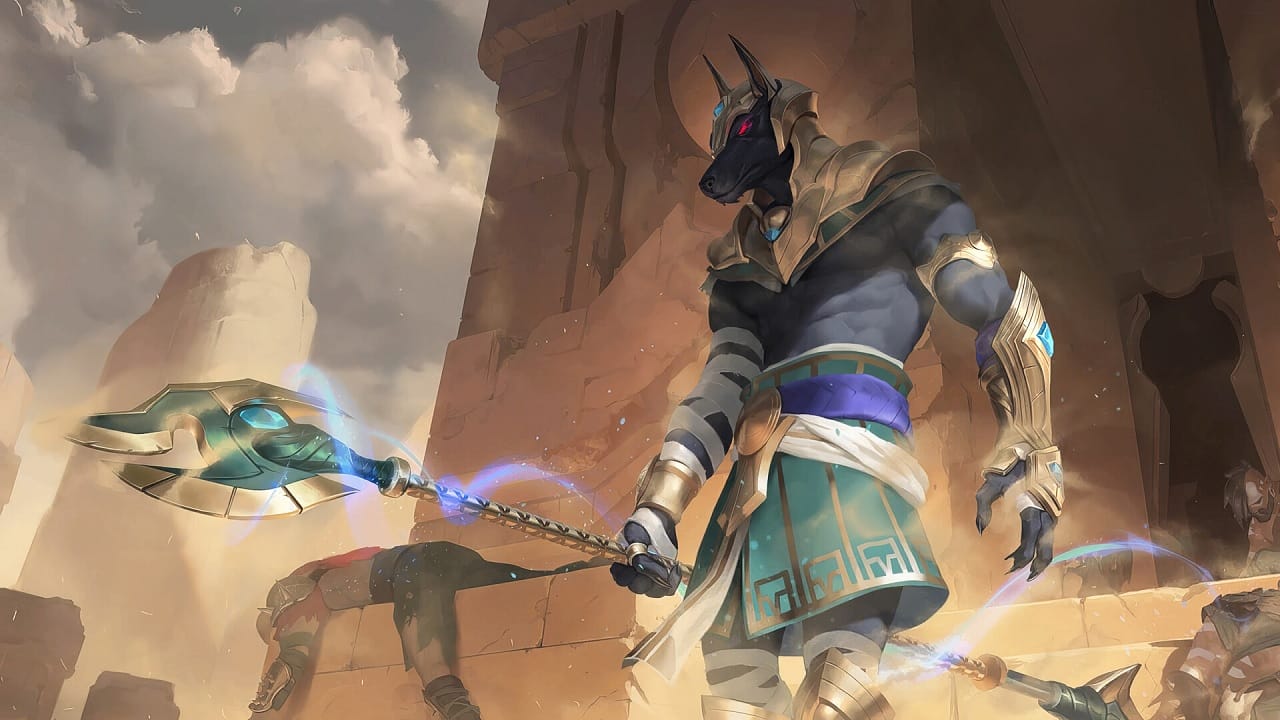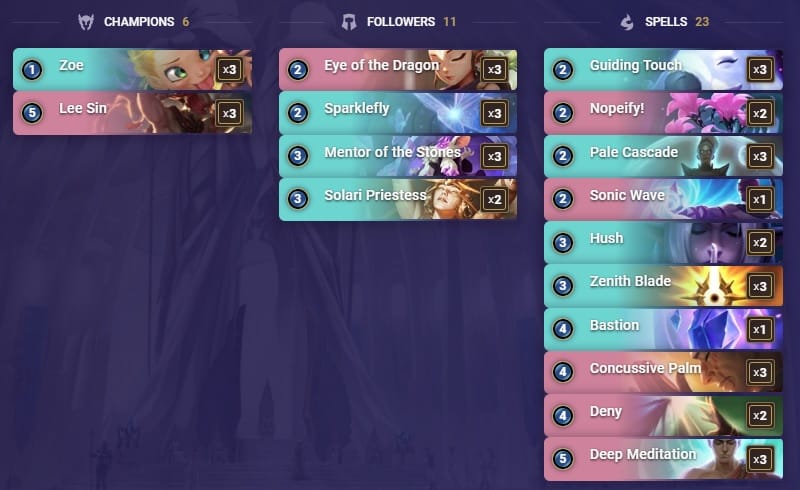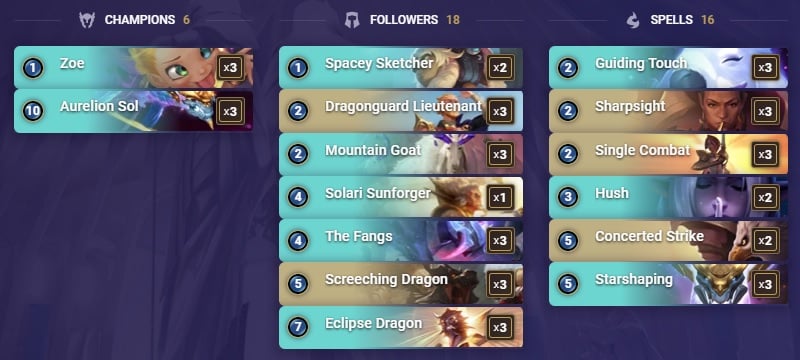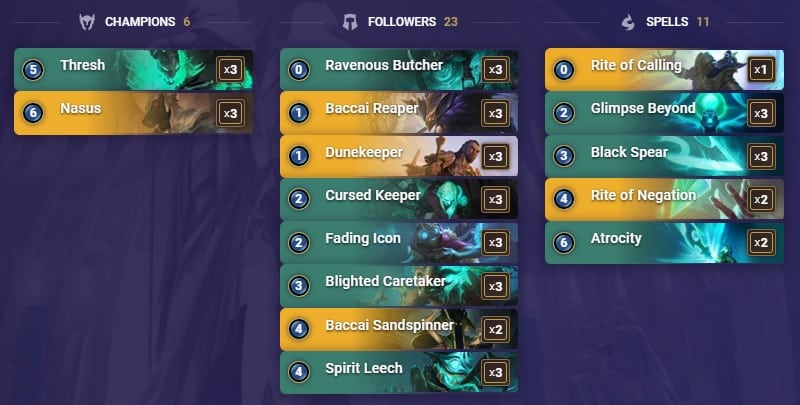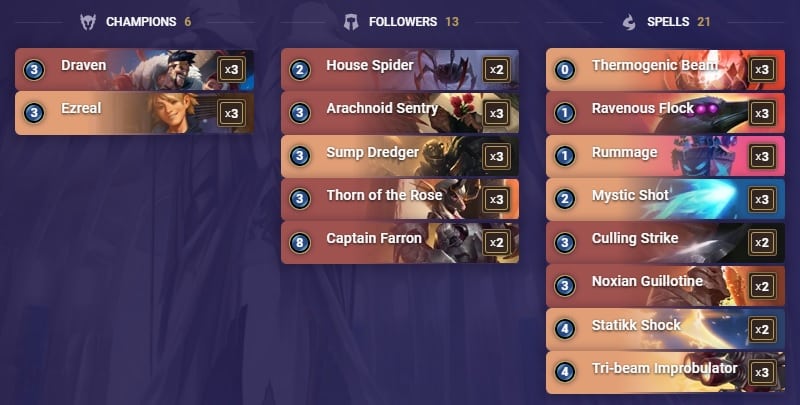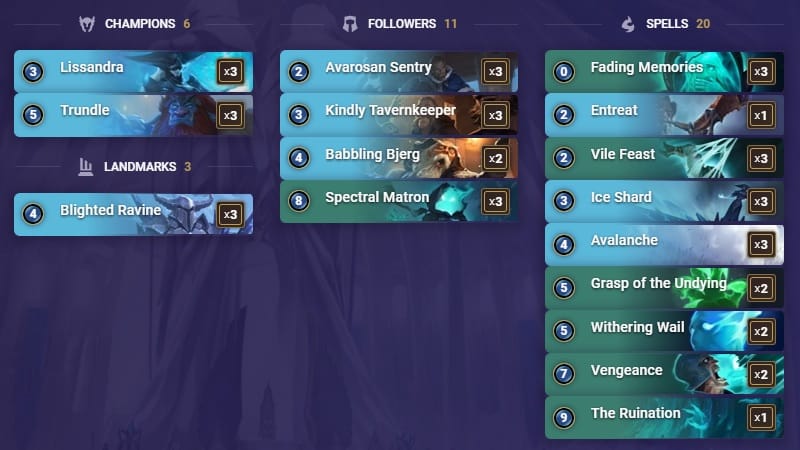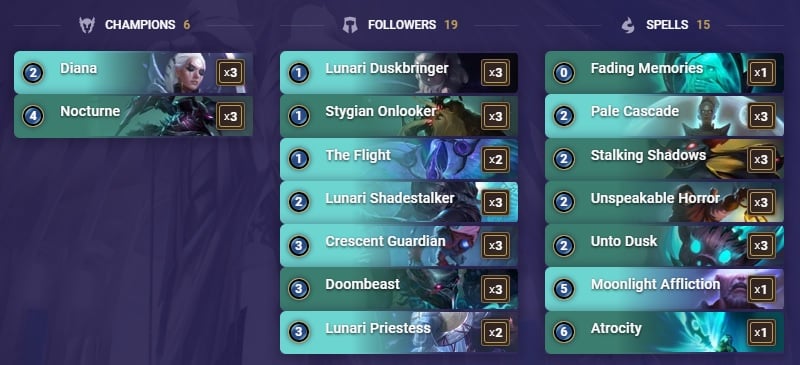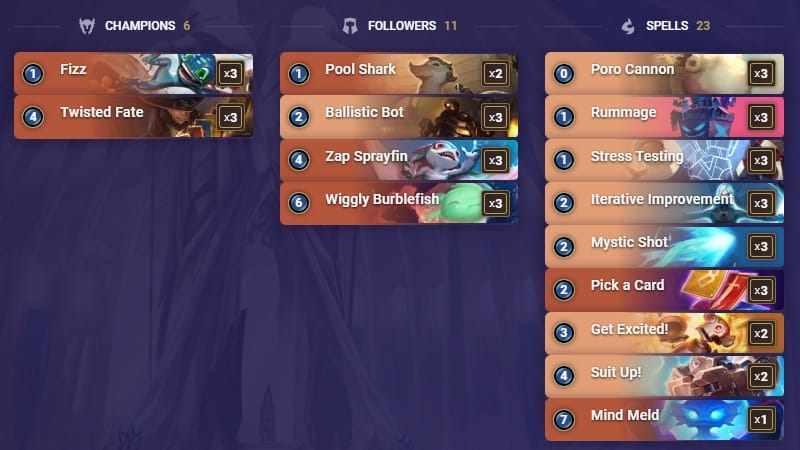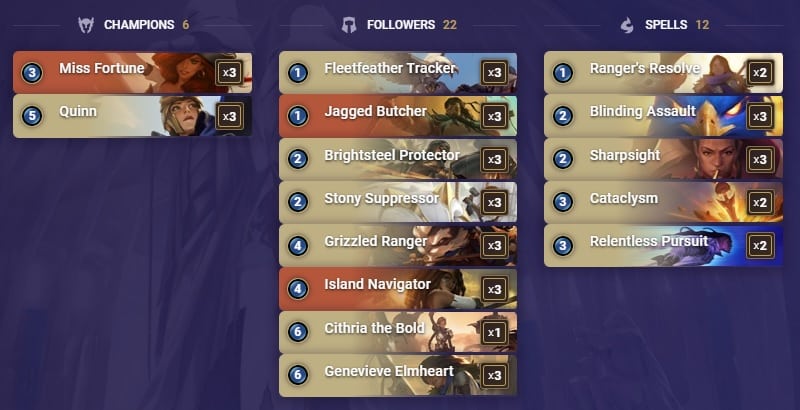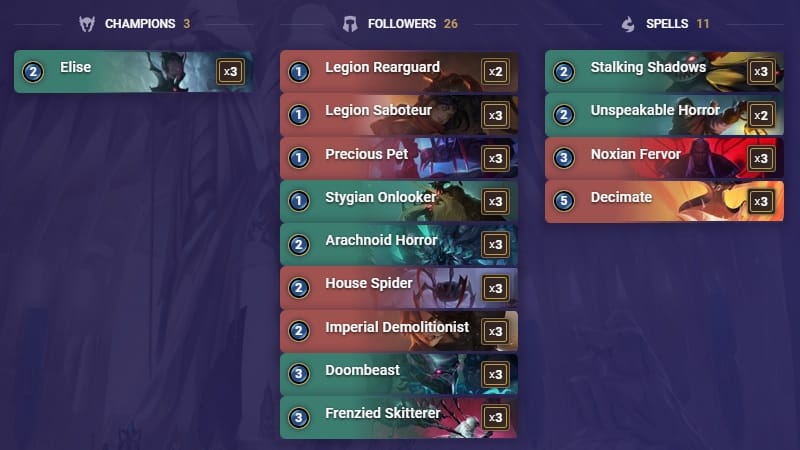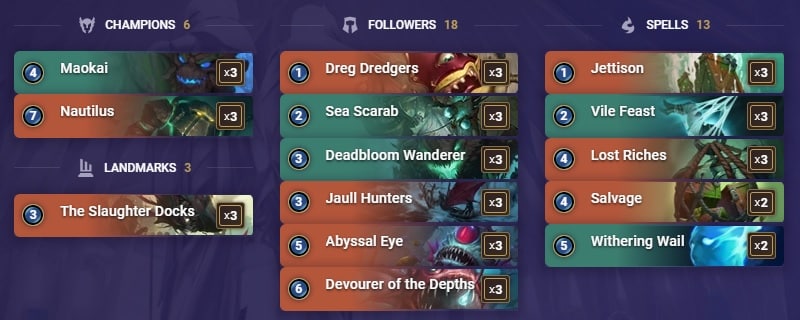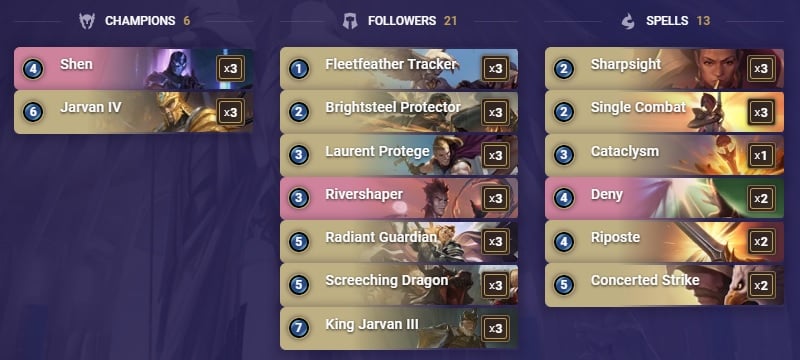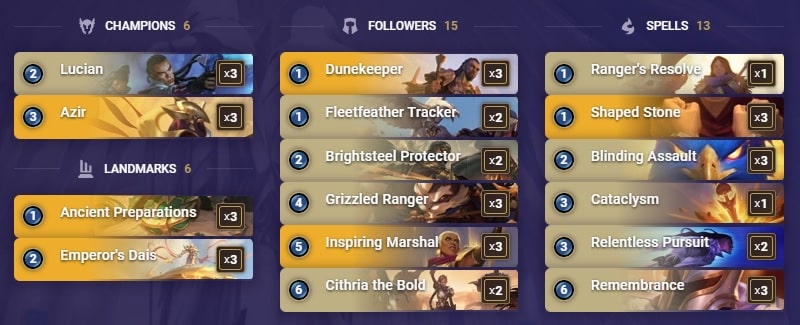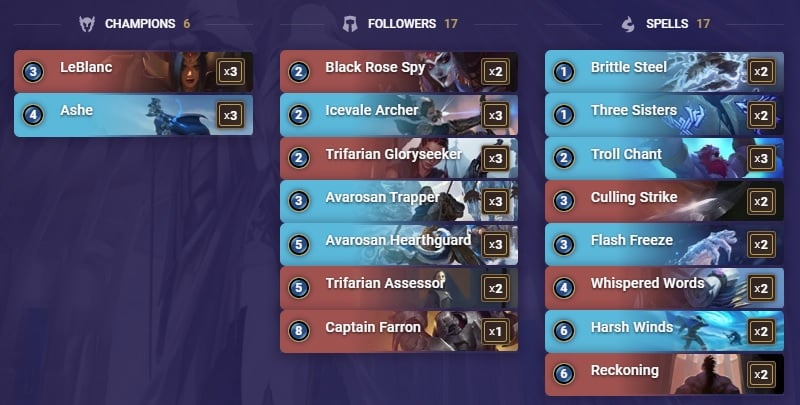Welcome to TLG’s latest meta snapshot for Legends of Runeterra, a series in which we give you our insight on the finest decks in the higher ranks of the ladder.
Every Monday, we discuss the decks that are part of the week’s meta and rate them on a scale of 1 to 5 stars. We also look at the evolution of said decks’ ratings across weeks and draw conclusions regarding the current state of the game, all of this so you can delve into your own ranked journey with a head start.
With another week removed from the big balance patch, we’re getting a better idea of how the meta is developing in the longer term. Surprise, surprise - Targon is rising to the top. Zoe and her companions of Lee Sin and ASol will serve you well if you’re looking to play the best decks at the moment. Thresh-Nasus continues to do well, though, so if you aren’t a fan of Lee Sin or Invokes, then this Slay deck may be a good option for you.
We have bid farewell to Braum-Vlad, Lulu-Shen and Azir Burn, but we have Zoe-Diana, Spiders and Shen-Jarvan incoming. These last two in particular offer quite different ways to dominate the opponent. The former is pedal-to-the-metal, whilst the latter is much more calm and collected in its development.
If you have any questions, feel free to drop by our Discord. Best of luck on your climb!
Graphics: WellMax81
Editing: Wusubi, Sebodunum
Writers: Den, Ultraman, Othal, Kuvira

CEBAIAQCAMCQMCIGAMEQSGZDFAUTGAYBAMBBIAIBAIYQEAYJKVQAEAICAIEACAYJCM
Difficulty: Hard
Lee Sin was expected to be the “S tier” deck after the nerfs to Aphelios and Twisted Fate. Yet, he doesn’t seem to be living up to these expectations. This is because the meta is geared towards punishing combo decks that don’t invest enough resources into defending the board and healing. That said, the deck is strong and it will likely end up in the Top 3 when the meta calms down.
Overall, it still looks better for the deck than last patch, as even though the environment is very fast, the Elusive mechanic that Fizz-TF was pushing is largely gone, and aggressive decks are much easier to contain thanks to Eye of the Dragon’s summons. This difference makes a huge impact and pushes the deck from being unplayable on ladder to being a risky but strong choice. Experienced players shouldn’t overlook the deck for tournament play or simply for climbing the ladder.
In order to be effective, though, I felt like a little tweak was necessary. As a result, we’re focusing on Lifesteal. You’ll also notice the list doesn’t run Mountain Goat and features Solari Priestess, a much slower card. A Turn 2 Mountain Goat isn’t good in the current meta with almost every 1-drop being a 2/1, making Sparklefly and Eye of the Dragon much stronger 2-drops to go with.
Solari Priestess helps us get various useful cards in the deck, either to remove board, to draw Lee Sin (Written in Stars) or to get some Lifesteal through The Golden Sister. While this is just a minor change in the list, Lee Sin doesn’t need to reinvent its core to be successful. He does, however, need to find a way to adapt to the flurry of Aggro decks that are prominent at the moment and prevent him from returning to dominance.
Whether or not the deck is flexible enough to accomplish that will be discovered in the coming weeks. (Write-up by den)
CMBQCAIADIBQGAAGBAHAOAYJBEZVIV24MTOQCAQBAIAACAQDBFKVMAIBAMETS
Difficulty: Moderate
After the nerfs to Aphelios and The Veiled Temple, players are trying to figure out what the best Targon decks are in this meta. For now, Lee Sin/Targon and Demacia/Targon seem to be the decks with the highest potential.
Zoe-ASol is a Midrange/control deck that can be built around Targon’s Invoke package, or around Demacian units and spells. This version focuses on dealing with aggressive decks as effectively as possible with cards like Solari Sunforger and The Fangs, especially when combined with combat tricks like Single Combat and Concerted Strike.
The Challenger units like Dragonguard Lieutenant and Screeching Dragon are great units against Aggro and Midrange decks with protective spells like Sharpsight to force out good trades. Eclipse Dragon and ASol are basically how this deck wins against decks that are even slower.
Don’t hesitate to use Eclipse Dragon’s Nightfall effect instead when you don’t have ASol or when you need units. Even though Zoe’s level-up isn’t the main focus of this deck, keeping Zoe in the back row and protecting her with spells is often a good idea, as this can put a lot of pressure on the opponent.
Embrace this (relatively) old favorite in order to put the Aggro decks infesting the meta in their place! (Write-up by Kuvira)
CMCACAQFAQBAIBIDCABQIBYCDIXQKAIFBMRDAMJUAIAQCBIZAICAOO2RAEAQIB3Z
Difficulty: Easy
In a very similar fashion to old Endure, which featured Thresh alongside a spider core, Thresh-Nasus relies on a swarm of cheap followers in order to threaten Thresh’s level-up. If Nasus may be easy to deal with coming onto the board at a 6 mana cost, he’s far more of a pain to deal with when pulled out of the deck onto the battlefield directly by a leveled Thresh’s lantern.
This method of summoning Nasus means you should have the mana to use the likes of Rite of Negation to nullify any attempts to remove the big dog. However, with such high defense against trades and an early swarm of sacrificial targets able to trade blows with most Aggro decks, your biggest weakness will naturally be Targon. Hush is painful, as it deals with unleveled Nasus at the unanswerable burst speed.
Although Nasus may be the flashy finisher, Thresh is the true mastermind behind the whole deck. This is because his body and ability to trade will frighten most aggressive decks, while also helping you take advantage of control decks desperately trying to deal with your pressure. Watch as your Lissandra-Trundle opponent has to play Avalanche, leveling your Thresh in the process. (Write-up by Ultraman)

CMCQCAQDBEAQGBARAECAGCQCAEBRILQFAECACGZEEY2AEAIBAQPQIAIDAQLDGNYA
Difficulty: Easy
By being both easy to play and incredibly stable, Ezreal-Draven will always be able to compete in a similar way to the curved Aggro decks (e.g. Burn and Scouts). The biggest difference between them is that Ezreal-Draven adds a great flexibility to the straightforward gameplay. This means it offers both an easy recipe to follow for the less experienced players, as well as some outplay potential for the expert players.
With the disappearance of most landmark-based strategies, Scorched Earth comes and goes depending on what you’re facing. Noxian Guillotine is a better overall card, offering you more value and more fuel for leveling Ezreal. It can also serve as a discard target to cycle your cards with Rummage. The ability to cycle your deck until you find enough damage to win the game is the most important aspects of this archetype.
Initially, losing Fiora-Shen hurt Ezreal-Draven, as this amazing matchup was a staple in the meta for a long, long time. Yet, the proliferation of Demacia in varying forms (e.g. Zoe-ASol, Scouts, Lucian-Azir or anything Lulu-related) has served up a decent amount of more excellent matchups to replace the late Fiora-Shen. As a result, we see a somewhat resurgent Ezreal-Draven climbing back up the rankings.
In addition to the favored matchups on the menu, the deck’s stability in an undetermined meta has helped it come back into serious consideration. Although the deck will basically do the same thing most games, this will be more than enough to beat most unrefined builds, without the risk of missing your win con and losing to a bad deck. (Write-up by Ultraman)
CMCACAYBAYBQCAIDCQZAGAIFFAWC6AYEAECQSDQCAEAQCBYDAECQCHJWAIAQCAI5AEAQKDY
Difficulty: Moderate
With the 3 best decks in the meta getting the nerf hammer, one might expect another staple of the Empire of the Ascended to come to the fore and claim the throne. Having avoided any change in the latest patch, it’s only fair to look at Lissandra-Trundle as a strong contender for the position.
The current meta is aggressive and the combination of Shadow Isles and Freljord has always been one of the best answers to Aggro in the game. With a solid board clear, some healing and big bodies, this deck is capable of resisting early game pressure while setting up its own pace in the game.
Additionally, the win condition offered by Watcher is sudden enough to allow you to come back from a losing position, as most decks won’t have an answer to seeing their decks obliterated in one attack. But Lissandra’s time of domination is halted by SI’s longstanding bitter rivals in any meta: Targon and Ionia.
These two regions have answers to Lissandra-Trundle through Deny and Hush, but the new Lee Sin build also brings solutions of its own. Not only is the Blind Monk able to finish the game earlier than Watcher when given time to set up, his current build also includes three copies of Concussive Palm to prevent Watcher from attacking. While situational, Zoe can generate Equinox to silence Watcher, or Crescent Strike to stun it.
Another problem is the presence of Deep on the ladder. Nautilus is able to recreate a deck and stunlock Watcher, while Maokai obliterates your own deck, which is less than ideal, to be honest. But even without Deep, Lissandra-Trundle will struggle to find a top spot in the meta as long as Ionia and Targon are there as well. (Write-up by Othal)
CMAQYAYJBERTGOCJJRKFKVS4LZQAEAIBAUMQCAYJFIAA
Difficulty: Moderate
Fizz-TF was - and still is - one of the sole counters to Targon. Many would agree that its nerf has freed up the meta, but others could fairly point out that it has also opened the door for even more Targon domination. This take on Zoe-Diana, specializing in Invoking big Celestials with Spellshield, is especially good against decks that lack the means to remove them, as well as those that won’t be able to close the game soon enough to avoid dealing with them.
The Great Beyond and The Immortal Fire will carry you against most Midrange lists, often dealing half a Nexus of HP with their original attack before allowing you to finish the job with Atrocity! Outside of that win condition, Zoe acts both as an early threat that generates value and a long term win con if unchecked for too long.
The early value will help you hold your ground and make the optimal use of your mana, while Diana will help you answer some lower HP threats, such as Twisted Fate or the opposing Zoe.
If your Zoe levels up, prepare for the Elusive fiesta, as from then on all the keywords of summoned units will be assumed by the whole board. This can allow even the cheapest of minions to transform your easily answerable board into an unstoppable force! Add to that the potential Spellshields, and your opponent is usually checkmated. (Write-up by Ultraman)
CECACAYECIAQEBADAQAQGCIUE43QOAIEAEGA2HBHFAWQAAIBAECDI
Difficulty: Moderate
Now that Fiora-Shen is gone, Discard Aggro can claim the title of the “oldest-yet-still-competitive” archetype. It has performed pretty well during this first week after the patch. Just like it has always been, the duo of Draven and Jinx can develop a ton of pressure in the early and mid game.
In a meta dominated by aggressive decks, Discard Aggro looks to have solid tools to fight against both other aggressive builds and sustain itself sufficiently against slower decks if needed. The deck relies on the same old concepts of a board swarm in the early game and a transition towards high quality minions in the mid game with its champions and Crowd Favorite, which looks to be a good recipe for success against both fast and slower builds.
The important part looks to be the set-up during the swarming part of the deck, as once we’re in control of the situation, it’s about navigating it in a way that retains our advantage. But with a lot of other aggressive decks roaming around the ladder, being able to develop small units to take control of the board in the early game is key to developing our champions later on.
For now, it’s too early to say which of the many fast builds will end up being the best one, and Discard Aggro relies on different concepts than other pressure decks like Scouts or Azir Burn for example. If the meta ends up rewarding raw power level and immediate pressure, maybe decks like Lucian-Azir or Elise Burn could end up having better matchups overall.
But if flexibility becomes a key component, it looks like Discard Aggro can keep competing at all ranks. (Write-up by den)
CMBQCBAFBMCQGCJDHBEVSXQFAMCQEAYEAUDACAQDBFF5MAICAEBQSDICAECRSLY
Difficulty: Hard
Diana and Nocturne are finally reunited in the Nightfall archetype, one that disappeared when Aphelios was released, but now seems to be regaining popularity. Joining the many pressure-oriented decks we have on this snapshot, Nightfall looks to take over the board early and get a set-up where Nocturne and Crescent Guardian can be major threats for the opponent.
The rest of the build is aimed at damaging the opposing Nexus through the Nightfall mechanic and keeping the opponent on their toes at all times. The recently released Unto Dusk also finally looks like it has a deck where the card can truly shine.
What separates this deck from other pressure-based archetypes is the Targon region, one that is usually seen as a Midrange (e.g. Invokes) or at least a value-oriented region. Having the Lunari Priestess in the list helps with escaping tricky situations by utilizing tools that the opponent can’t prepare for, which gives the deck more flexibility.
Unspeakable Horror is another card that can help with that surprise element against an opponent that would have ways to answer your primary aggressive gameplan. It’s also valuable against faster decks (removing small units) and the very popular Demacia region (removing barriers before going into combat).
While very new in this meta, Nightfall is known for its capacity to dominate the early game and transform that situation into heavy damage, a combination that looks to be working for a lot of decks lately. It will probably take another week to see which Aggro decks come out on top, but don’t count Nightfall out in this battle - it could go to the moon! (Write-up by den)
CECAIAYEAUGREGIEAIDBUJRLFYBACBABGQAQGBQRAMAQEBQJAEAQIJYBAICAGAIBAIDCU
Difficulty: Hard
The king of the previous meta hasn’t evaporated entirely (as some would’ve hoped) - it still appears to be playable. However, it’s much harder to pilot now. In addition, the aggressive environment doesn’t help the deck at all. Despite all this, Mind Meld and the Elusives remain a great way to close games.
Slower decks that were biding their time until Fizz-TF received some nerfs aren’t as competitive as some may have expected; defensive cards are still important inclusions in lists for now. The main difference in the deck’s matchups after the changes is related to Aggro decks, as TF’s level-up won’t save the day as often as it used to. It’s now more important to establish a robust board presence and stay safe from the opposing pressure plays in those matchups.
While it’s obvious that Fizz-TF can’t pretend to be the best deck in the game anymore, people would be remiss to automatically dismiss it. For now, it looks like its winrate is still very good across most ranks. Don’t worry too much, though, as this is probably because of an expectation that the deck would vanish from competitive play, which has led to players failing to account for its everlasting presence on the ladder.
Once the meta becomes more clear and Fizz-TF finds its real position in the new environment, the deck should stay relevant but counterable, making it more matchup dependent instead of being the overpowered juggernaut. (Write-up by den)
CECAEAIABEOQEAYABYHQGAQGCY5D4BACAABAMCIKAMAQEAAHAECAAAYBAEABKAIBAEADG
Difficulty: Easy
The Scouts archetype has been very up and down for a while now, either feeling like a great meta pick or being almost invisible for extended periods of time. In this patch, the deck feels like it’s slowly finding its groove. Its capacity to build steady pressure helps it a lot against the control decks around at the moment, such as Deep and Lissandra-Trundle.
True to its nature, Scouts still play a board-dependent game plan that relies on building up an army of small and medium-sized minions that we can use to level-up Miss Fortune and Quinn with their attacks. Alternatively, you can try to set up a huge burst turn thanks to buffs and recurring multi-attack turns. This potential dual approach keeps the opponent on their toes and forces them into playing reactively rather than proactively, which may make their own game plan quite awkward.
Higher ranks are seeing a flurry of aggressive decks appearing in this first week, so Scouts can’t shine as much as they could in a slower meta. Having said that, Scouts can still climb steadily and be considered a good pick. Miss Fortune, even though she was nerfed not so long ago, still represents a threat and is a “must kill” target for any opponent. This is even more so now that Cataclysm has become a staple in a lot of lists.
The other card that can aid Scouts is Stony Suppressor, a very simple but extremely effective card lately, with spells becoming more and more important as support tools in the game. It also helps that the card makes most Lee Sin opponents concede on the spot when they understand their whole deck is now at +1 mana.
As Scouts’ main support in combat is Miss Fortune, Stony Suppressor is almost always more detrimental to our opponent than us. Even against more unit-centric decks (e.g. other aggressive decks), Stony Suppressor can block 2/1 units and Sand Soldiers, all the while forcing more mana to be used for combat tricks during our attack turns.
The deck had a great time in the first few days when Deep was massively popular, but the comeback of other Aggro archetypes might force Scouts to remain a tournament deck. The list presented here aims at beating the more control-oriented strategies, but adding cards like another Ranger’s Resolve or Riposte would help against faster strategies. (Write-up by den)
CMCAEAQDAMCAGAIFE42TQAYDAUBQIBQEAEBQEDZIG4BACAIDBQAQGBICAA
Difficulty: Easy
If you’re looking for an early game deck that’s easy to play, look no further than Spiders. With its numerous low-cost units and synergies, the idea is to apply as much pressure as possible before delivering the finishing blow through direct Burn damage.
This game plan is supported by a flurry of cards that allow you to overwhelm your opponent’s defenses before they can even think about playing to their win conditions. Your cheap units are straightforward and have some additional and bothersome effect. For example, Precious Pet is a 1-drop Fearsome, while Legion Saboteur’s ability helps you whittle down the opposing Nexus every time it attacks.
Always keep track of the amount of Spiders you have - while it’s not a straight win condition, getting Elise to evolve can change the whole board with small Spiders challenging enemy units to allow the bigger Fearsome creatures to go through unblocked. These Fearsome units are a key part of the deck, with most decks in the meta lacking solutions to tackle them early on.
While Precious Pet and Arachnoid Horror are very dangerous, Stygian Onlooker can push 4 damage straight to the opponent’s Nexus for just 1 mana, all on its own if played correctly. And if your Fearsome units look like they can’t go through the blockers, worry not: Frenzied Skitterer will help. Not only will it boost Spiders, it can make the opposing units go under the 3 attack mark, giving you a free turn of attack for your Fearsomes to feast on.
It’s Turn 3 or 4, your opponent has too many blockers and your board can’t get any meaningful damage in? Well, that’s is why this deck is a Burn deck and not solely a board-based Aggro one. This is the type of deck where even the first couple of turns should have allowed you to get the opponent’s Nexus low enough for the Burn cards to do their job.
Decimate, Doombeast and Imperial Demolitionist are all cards that will be able to seal the deal, while Noxian Fervor is a great reaction card to use when your opponent tries to remove or favourably block one of your units.
The most complicated card to use in this deck, and one of the strongest ones, is Stalking Shadows. It offers a lot of flexibility, so you will need to understand which unit is the best option. Should you go for a double Doombeast to Burn the opposing Nexus, or for a double Stygian Onlooker to have two 4/1 Fearsomes for your attack turn? Or maybe you need another Frenzied Skitterer to make sure there are no blockers left. (Write-up by Othal)
CMDACAIFFAAQGBQBAECAMCABAQCQ6AQCAUEAUBQCAYSSOLBPGU4AEAIBAUOQCAQGDUAA
Difficulty: Easy
Before the latest patch, Deep struggled to find its place in the meta. While it had a favored matchup into Lissandra-Trundle, its slow game plan would play right into the hands of decks such as Fizz-TF, Fiora-Shen or Zoe-Aphelios. But with these archetypes being nerfed and Deep’s early game receiving buffs in the forms of upgraded Dreg Dredgers and Sea Scarab, it was only logical to see it return to the ladder.
The deck hasn’t changed and neither has its weakness: it’s a slow defensive deck and it has a hard time surviving early pressure. In the early game, Deep won’t be able to contest the board. Most of its Sea Monsters are weak at this stage because they need to go Deep to shine, or because they’re here to provide some Toss or chump blocking to power up Maokai.
Since you have to go Deep in order to proc your win conditions, your best possible Turn 3 will generally be The Slaughter Docks, followed by a Turn 4 Maokai. The issue is, most decks on the ladder won’t let you execute this game plan, so you’ll either need to slow down going Deep, or take the plunge and tank some hits. Given the highly aggressive meta we’re in, tanking might quite suddenly spell defeat.
Deep is a prime example of a “good, but meta-dependent” deck: while it will always be able to punish some decks, it doesn’t fit the overall playstyle of this meta and will thus stay in the lower tiers until the meta shifts. Indeed, the slow disappearance of its best matchup (Lissandra-Trundle) and the rise of the tempo king (Lee Sin) will sink this deck even deeper. (Write-up by Othal)

CMCAEAICEAVQEAYAAYHAEBAABAFAKAIABEFQ6GQ5AMAQCABFAEAQEMIBAIAACAIBAQAAG
Difficulty: Moderate
With Fiora nerfed, Shen needed to find a new partner to keep the Demacia/Ionia archetype going. Thankfully, he found it with Jarvan IV. The secondary win condition that Fiora provided is gone, so the deck focuses on the Barrier synergy and controlling the trades and the overall pace of the game. It’s obviously a bit slower than its predecessor and for now, it doesn’t feel like it has enough potential to reach the power level of Fiora-Shen.
But let’s talk about what the deck can do, as there are some upsides to it. The biggest one is the fact that it can dominate the other Midrange decks from the early game up to Turn 6 or 7. While Fiora was a great champion, removing her from the deck has given Shen more room to shine. Barrier synergy is certainly a slower way to build our win condition, but it can also be seen as a more reliable way of doing so.
Shen has good survivability in the current meta, making him a reliable unit to capitalize on for a long period of time. He also has a ton of support in both regions, making the deck quite flexible. It can shift with ease between focusing on board development, Nexus protection or applying pressure through Rally.
The list featured here tries to build the board, control the trades with Challengers and Barriers and win the game through sheer tempo and denying the opponent the opportunity to develop their own game plan.
Jarvan IV acts as the late game threat, generating tons of value if leveled-up, which should happen in the early stages. Once on the board, J4 is an incredible pressure tool thanks to Cataclysm. This removes one unit per turn, supporting huge power swing turns when King Jarvan III turns up and gives Challenger and Scout to all allies if his son is on board. Unsurprisingly, the deck feels very different depending on whether J4 is leveled or not.
One interesting take that has been seen in the deck is the response to the question of how to protect our Nexus. The answers have tended to be going with either Radiant Guardian or Spirit’s Refuge, as both cards have a lot of merit.
For our purposes, we’ll go with Radiant Guardian. This is because her Tough status is good against the resurgent Ezreal-Draven; she can offer sustainable healing over multiple turns. Including this card means, however, that we have sacrifice units in order to activate her Lifesteal. To help with this, Fleetfeather Tracker has been included over the more obvious Greenglade Caretaker.
Although very much still a work in progress, Shen-Jarvan looks promising. Yet, it clearly cannot support any comparison with the past iterations of Fiora-Shen, as it lacks the ability Fiora used to provide to win games from another angle. This deck can only focus on board pressure, so it suffers in the way all solo win con decks do. (Write-up by den)
CMBQEAIACYQQEAQAAIEQMBAHAMNBYMZZLUAQIAIABEKR2MYCAEBAABYBAQAAG
Difficulty: Moderate
Lucian-Azir was the deck to beat at the start of the Shuriman expansion, but quickly left the stage, needing too much set-up to work effectively in such a strong meta. However, with Aphelios and TF out of the picture, a lot of decks will struggle answering everything this deck has in its arsenal.
Sooner or later, this means the deck will be able to set itself up and force the opponent into making some serious sacrifices in order to avoid taking tremendous damage too rapidly. The Sand Soldiers aren’t a problem at first, but they erode the opposing Nexus piece by piece, while leveling up Lucian and Azir.
The impact of your champions shouldn’t be underestimated, as they end up creating bigger, stronger threats and forcing even more sacrifices from the opponent in order to stay alive. Eventually, your opponent will run out of units or mana. This will be the time to Rally and combine cards like Cithria the Bold and Inspiring Marshal with your Sand Soldiers to chase the sun to victory. (Write-up by Ultraman)
CMCACAIDD4AQGAICAECAGBAEAEAQWJRJGACACBABBIBAIAYCAYBQCAIBDYVAGAIDAQQTKAIBAEBTG
Difficulty: Easy
Ashe and LeBlanc make for a perfect pair, each of them being 5+ attack champions, both helping each other gain Reputation and card draw in the form of Trifarian Assessor and Whispered Words.
It’s useful to have more bodies that can activate Reckoning - this card is crucial to survive against Aggro and Midrange decks. Those two archetypes are, paradoxically, both the reason Frostbite is able to perform and the reason it doesn’t perform too well in the current ladder environment.
With the multitude of aggressive decks out there, this list has trouble staying alive. The combination Freljord and Noxus lacks healing and cheap removal to deal with the swarm of minions that’s so often seen on the ladder at the moment.
On the other hand, it has a great matchup against decks that focus on trading, such as Demacian decks. It also has a decent matchup against Lee Sin, due to its Freeze cards, but can often sometimes to finish the game unless a well-timed Reckoning can avoid the opponent’s Deny. (Write-up by Ultraman)

